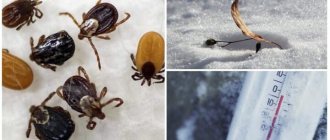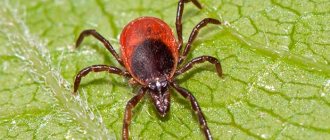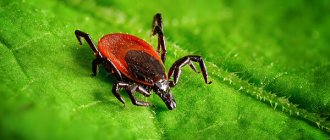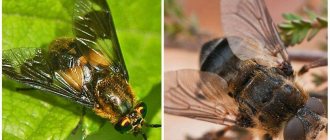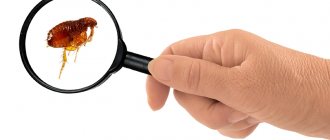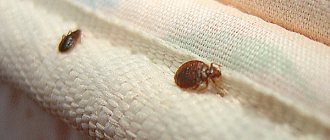Ticks only crawl, and slowly. An adult can crawl about 10 meters during its entire life cycle. The tick can move over long distances using “transport”. Transport is the body of the victim, be it a bird, a dog, a cat, or a person. Without suspecting anything, you can lead a tick hundreds of kilometers away from its natural habitat.
When there are no potential victims nearby, ticks hardly move. Having taken an advantageous position for attack, they wait for the appearance of a new owner. If passive “spider” hunting does not bring results, the pest begins to move to other positions. Having felt the warmth or smell of the victim, slowly but surely, the ticks will move towards the source. Special sensory receptors help them navigate in space. With their help, bloodsuckers determine the location of a potential host, with an accuracy of a centimeter.
Having settled on a blade of grass or a small bush, the tick becomes invisible to humans. The attack is carried out using tenacious suction cup limbs. Having caught on a pant leg or on the hair on a leg, the tick will move along the body, looking for the most tender place. Usually these are the armpits, groin, neck, head. Having found a suitable place for a bite, the bloodsucker bites into the skin.
Can ticks fly and are there flying ticks?
Every spring, all nature lovers should be careful, since it is at this time, with the first warm sunny days, that ticks become active.
Advice! Among those who have encountered them in the taiga, and sometimes in the Black Earth Region, there is a strong belief that flying ticks exist as a type of ordinary parasite. So do flying ticks exist?
You can answer with complete confidence - flying, jumping ticks do not exist in nature. All parasites of this family found in the world hunt and feed, hiding in the grass, they react to the smell of a person.
They also do not fall from trees and bushes, as some people believe. The main reason for these misconceptions is that bloodsuckers strive to rise as high as possible to a person’s head, where they are mainly found later.
As a result, the victim believes that the tick fell from the tree, although quite recently it was just sitting on the grass and then gradually climbed up from the level of the knees onto the clothes.
Ticks also cannot fly. Most often they are simply confused with the “Deer Bloodsucker”, which feeds on the blood of wild boars, deer and other animals. It's not a mite, but there is a slight resemblance. The “deer bloodsucker” is often found in Siberia and Scandinavia, but practically does not attack people if there are wild animals on its territory.
When the victim approaches, it takes off and heads towards its scent. After a quick capture, the parasite moves to the hairline and begins to drink blood.
It is worth noting that the “Deer Bloodsucker” or “Moose Fly” is not afraid of danger and cannot be scared away. Until it stings a person, it will not stop attacking - this is a feature of this type of blood-sucking species that does not encounter resistance from wild animals.
Her bite is very painful, but she does not bite right away, as she waits a little, trying to gain a better foothold. Once it attaches itself, it is more difficult to remove than a tick.
The bloodsucker sheds its wings, becoming smooth, and it also has very tenacious legs that help it stay on the victim. Moosefly can give the victim Lyme disease, another type of fever. Cases of infection are not recorded due to the great distance of its habitat from civilization.
Important! To protect yourself from insect bites, you should use special products and dress properly. For example, innovative insect repellents DEET
They are suitable for both adults and children. They effectively cope with their task, and their price is quite affordable and affordable for everyone.
There's nowhere to hide
Ticks are the most numerous representatives of their class. In total there are more than 54 thousand species. And new ones are constantly being added to the existing ones. So, in 2006, a graduate student at Moscow State University found previously unknown oribatid mites that lived 6 thousand years ago. And recently, scientists from Tyumen University discovered a new species of this group of arachnids in South Africa. The discovered mites feed on fungi and spread by attaching themselves to the body of termites.
According to researchers, termite mounds in South Africa as a habitat for arthropods have not been particularly studied, so this is probably not the last interesting find. Photo:
Without exaggeration, you can meet ticks everywhere: even in the Arctic and Antarctic, where they parasitize penguins and other birds. There are also aquatic species, the victims of which are insects and bivalves. What allowed ticks not only to survive for so long, but also to multiply to incredible numbers? Their amazing ability to survive.
Thus, Discover published an article about the experiment of Yasuhito Ishigaki from Kanazawa Medical University. He photographed the moving mites using a scanning electron microscope.
To obtain an image on this device, small arthropods had to be first dried, coated with metal, and in the microscope itself they were in a vacuum and subjected to “bombardment” of high-energy electrons. Few would withstand such conditions, but the ticks in the video are cheerfully “waving their paws.”
Ishigaki o.
People started talking about adaptation of animals in vacuum conditions after experiments on tardigrades. These microscopic invertebrates, which are closely related to arthropods, show amazing endurance, surviving in extremely low temperatures, high pressure, radiation and outer space. But in order for their superpowers to work, tardigrades need to go into suspended animation, while ticks survive in their normal state. Photo:
Life cycle
The vital activity of ticks begins when the air temperature rises above 1°C. The mating season for ticks is May-June. After this, the fertilized females drink the blood and begin to lay eggs. Tick activity subsides at this time.
How many eggs a tick lays depends on its type and life expectancy. A female tick can lay from 100 to 17 thousand eggs in her life. In nature, ticks lay eggs in soft, moist soil. In urban conditions, how will it work? If the female “arrived” at the apartment on a dog and was not noticed, she will lay eggs right in the living room. After some time, the apartment will be filled with actively moving transparent larvae 0.5 mm in size.
Tick development cycle
Stages of development
The maximum number of development stages in parasites is 4:
- egg;
- larva;
- nymph;
- imago.
Tick eggs are very large in size relative to the female. They can be of various shapes, with a smooth or textured shell.
After some time, depending on the temperature and humidity of the environment, mite larvae emerge from the eggs. These are very small organisms measuring no more than 0.5 mm. They look almost like adults, but have only 3 pairs of legs. The tick larva does not have its own name, since it has only one stage of development.
Knowing about the “three times a day” diet of acarids, many doubt whether the tick larva is really dangerous to humans. After all, she hasn't drunk blood yet. For many diseases, no, it is not dangerous. But encephalitis can be transmitted to the larvae by a female tick during egg laying. Therefore, even a larva can infect encephalitis. And therefore, it is dangerous for humans.
After consuming blood, the larva falls into torpor and transforms into a nymph. This stage takes a little time.
Three stages of nymph development
The development of nymphs occurs in 3 stages. Each stage has its own name for nymphs:
- protonymph;
- deutonymph;
- Tritonymph.
The tick nymph is distinguished from the adult only by a smaller number of bristles on the paws and genitals, a smaller number of genital tentacles, and a smaller size. The size of the nymph is 1-1.5 mm.
The tick nymph is much more dangerous to humans than the larva. You have to be “lucky” to stumble upon a young arthropod infected with encephalitis right from the egg. The nymph had already fed once on her own and could drink the blood of a sick animal.
Some species of ticks skip the deutonymph stage, others do not go beyond the second. In ixodids, the main factor triggering the transformation of a nymph into an adult is blood feeding. If the nymph remains hungry, she will go to winter without turning into an adult.
Generation of tick generations
Imago
After the mechanism of transformation of the tritonymph into an imago is launched, the nymph experiences serious changes in the structure of the body:
- the structure of the external integument becomes more complex;
- the number of bristles increases;
- in higher species the following are formed: trachea, shell, pteroforms, plates and much more.
“Full-fledged” mites are born only after the tritonymph moults. In structure they are very different from larvae and nymphs.
Where does everything go?
To accumulate and store the nutrient fluids they receive, mites have a coating of elastic cuticle . If necessary, it stretches and contains everything that the insect sucks. The structure of the cuticle in females and males is somewhat different. As a result, in females it straightens and stretches noticeably more. This allows females to accumulate more necessary nutrients. Why? Because they need to raise their offspring. To achieve this, nature provided them with certain nutritional advantages compared to males.
The legs of ixodid ticks have tooth-like projections that allow them to hold tightly to the surface of the host’s body. Especially when they get drunk. At the ends of the paws there are two powerful claws . Between them there is a kind of “pad”. It acts like a suction cup, which further fixes the position of the parasite on the victim.
What to do after a bite
If an arthropod was caught “in flagrante delicto,” it is carefully removed, placed alive in a jar, and taken to a laboratory for examination. If traces of an attack are found without the bloodsucker, the irritated area is lubricated with an anti-insect bite remedy.
Help with a tick bite
After an attack by an uncaught tick, a person will have to monitor his health for about a month. The incubation period for some Ixodid-borne diseases can last up to 30 days.
Victims often have questions about whether it is possible to wash after a tick bite. After all, in this case there is a risk of wetting the irritated area. But the bite is not a tuberculin test, although it is similar in appearance. You can safely swim after a tick bite or take a bath
All precautions are related not to traces of an attack, but to the state of human health. If a victim attacked by an arachnid has a weak heart, then the person may not be able to withstand the steam room
Playing sports is not only possible, but also necessary. An attack by blood-sucking arthropods would be no different in consequences from an attack by insects, if not for the delayed consequences. The likelihood of contracting infections from an insect is lower than from an arachnid. An insect drinks blood once, a tick at least 3 times - once for each stage of its transformation into an adult animal. The likelihood that he will first take a treat from a sick animal, and then transmit the causative agent of the disease to a person, is much higher.
Why are fleas so jumpy?
Scientists have been trying to understand how fleas jump for 44 years. Experts began to unravel the secret back in 1967.
Then G. Bennett-Clark discovered that before jumping, the pest accumulates energy in elastic pads located at the ends of the limbs and consisting of resilin (an elastomeric protein).
But scientists were able to get all the answers only in 2010. The mystery was solved by researchers from the laboratory of M. Burrows (Cambridge).
As it turns out, fleas don't jump in the dark. Based on this, specialists filmed videos in low light. So, scientists filmed 10 individuals making 51 jumps.
The video was then slowed down, allowing the researchers to study the movement patterns of the ectoparasites. It turned out that to jump, wingless animals use the joints of their hind legs as levers and springs.
It is noteworthy that 2 studies were conducted 50 years ago. The results of the experiments were the same. Thus, fleas gain the ability to jump due to the presence of developed muscles on their legs.
Studies have proven that wingless ectoparasites travel a distance that is 200 times greater than the length of its own body. The secret of this ability lies not only in developed muscles, but also in the spring-like anatomy of the body.
The discovery of scientists contributed to the emergence of 2 hypotheses:
- the parasite jumps, making a dash, on his knees.
- The insect is able to jump high thanks to the joints of its hind legs. The parasite gets on all fours and from this position jumps up and in length.
However, scientists M. Burrows and G. Sutton are confident that the secret has already been solved. After all, research results have clearly proven that the insect has spines on its hind limbs, using which it hooks onto the surface and pushes.
The researchers also found that the hind limbs of the flea beetle function as a single system of levers. The ectoparasite lowers its legs and then suddenly launches a “coil spring”.
Much of the mystery of the wingless ectoparasite's leap has been solved. But there are some aspects that remain unsolved. For example, it is not known how the insect folds its limbs to charge the “spring.”
Can all fleas jump?
Answering the question whether all fleas jump well, experts say no. Moreover, there are species of ectoparasites that are not capable of this.
Some varieties of fleas do not jump as well as their relatives. These insects live on birds and jumping is life-threatening for them, as they will lose their owner. In addition, they have poor eyesight, and the birds create their nests at high altitudes.
In species that are poor jumpers, the parameters of the pleural arch were reduced during evolution. But in return, they have long legs that allow them to climb to great heights.
Fleas cause a lot of problems for humans and their pets. But ectoparasites are unique insects. After all, they are capable of jumping up to 0.5 m in length and up to 0.3 m in height.
Description of the insect
The moose tick has many other names - deer bloodsucker, deer louse, deer tick. In fact, this light brown insect belongs to the bloodsucker family and the order Diptera.
The moose tick has a flat body 3-5 mm long - its main part is occupied by the head. Females are larger than males. The abdomen of this insect is very soft and elastic, stretches well during gestation and when large doses of blood are received. 3 pairs of asymmetrical legs with powerful claws grow from the chest.
The oral apparatus is piercing-sucking. The elk louse is “big-eyed” – the photo clearly shows two large lateral eyes and three smaller eyes. What’s interesting is that with so many organs of vision, the parasite sees almost nothing—it can only distinguish general features. By the way, the larger they are, the “tastier” they are for the tick. The main difference between this insect is its pair of wings, for which it is also called a fly.
The moose fly is attracted to large objects, such as elk or deer, but it can also attack humans.
The full cycle of formation of a larva into an adult tick takes 3 weeks. Then the insect jumps to the ground and finishes its development there.
The habitat of deer bloodsuckers is quite large - populations of these insects are found in Scandinavia, America, Siberia, China and the European territory of Russia. The number of parasites is closely related to the number of animals on which they live.
In fact, the moose tick is not a tick at all. This is what the people called the insect because of some external resemblance to it and the method of saturation. In fact, it belongs to the order Diptera, not arachnids, and is scientifically listed as a deer bloodsucker. It may also be called a deer flea or louse, moose fly or bug. It feeds only on the blood of warm-blooded animals.
Deer bloodsuckers settle and parasitize on such hosts as moose, deer, deer, and livestock. If these food sources are not nearby, they do not disdain a dog, fox, wolverine, or wild boar. They can penetrate a person’s hair, and then into the apartment, causing a lot of unpleasant sensations and inconveniences.
The small fly has a hard, flat body measuring from 3 to 5 mm, most of which is the head. There are five organs of vision on the head: two main and three additional ocelli. Despite this, the insect has poor vision, is oriented only by contours, and the larger the animal, the more attractive it is to it.
There are also dense transparent wings, but not permanent, only until the bloodsucker is on the body of the animal. After this, the elk fly sheds them, since the wings interfere with movement in the fur and now it looks like a tick or a spider with a large abdomen, but at the same time it has only 6 legs, and not 8, like all arachnids. Due to the color - from light brown to almost black - the flea is difficult to see on the animal's body.
Danger to people
In fact, attacks by these insects are quite common. They live in forest thickets, but in search of food they also visit other territories, so they can be found not only in forest areas, but also in fields. Most often they attack from above, jumping on their heads. This is due to the fact that this way they can cling to the hair and securely attach to the victim. It is impossible to predict the body's reaction to a parasite bite, since everyone experiences it individually.
Some people may not notice the bite at all, after which there will only be a small spot of red and color, and after 2-3 days it will disappear. Others, during a bite, feel very severe pain, after which the affected area turns red, inflamed and itchy. Situations are possible when a person has an allergic reaction to the saliva of the parasite and it occurs in a rather complex form.
The affected area becomes inflamed and swelling is observed, accompanied by severe itching. A rash and blisters may appear, and dermatitis may develop. If a person is predisposed to urticaria, he develops edematous dermographism. Symptoms do not disappear quickly and the condition can last up to 3 weeks.
When the body's reaction is severe, treatment with medications is required. It is worth saying that a person tolerates the initial attacks of the parasite quite easily. Since the small amount of toxins that enter the body is quickly neutralized by the immune system. But subsequent bites are quite dangerous and can be tolerated in severe forms.
Studies were conducted that showed that 25% of moose ticks were carriers of dangerous spirotechs. Spirotechans are the causative agent of Lyme disease.
Most often, these bloodsucking creatures attack adults, but do not attack children under 8-10 years of age. This feature is due to the fact that they parasitize large animals. But here it is worth considering that during periods of maximum activity, when they need food, they can attack any victim in order to satisfy their hunger. These individuals can attack a person in groups; there are known cases, and they are not isolated, when about 100 elk ticks attacked one person at once.
Deer bloodsucker
It is small in size, no more than 3.5 mm. The color is brown, the cover is dense and leathery. There are 8 eyes on the body, of which 2 are main and the rest are auxiliary. It is born and develops in exactly the same way as an ordinary tick - from the ground to the grass. Development occurs in late summer. The main activity occurs in autumn.
Danger to humans
The deer bloodsucker attacks people only if there is no suitable animal. In addition, the choice of victim depends on its size - the smaller the person, the less likely it is to be attacked. Despite the presence of wings, the creature flies very poorly. It senses prey by smell and warmth. If it finds a suitable option, it takes off from the grass or bush and, focusing on the warmth, attacks the victim.
How does suction occur?
After contact with the body, it freezes for a while, after which it begins to crawl upward and gets lodged in the hairline or under baggy clothes. Does not sense danger in sudden movements and will not leave the body on its own.
It is removed with great difficulty, since the flat body constantly slips out, while the fly holds on to the skin with its tenacious limbs and drops its wings. After “entering position,” the creature waits about an hour and begins to feed.
Consequences of a bite
The difference from a tick is evident in the bite - it does not go unnoticed. There is a painful sensation, itching and burning. Allergies may occur. After the bloodsucker leaves the owner, the bite area becomes covered with a crust and lasts for 15-20 days. Like any insect that feeds on blood, flies can carry various diseases, such as Lyme disease.
Method 2. Thread
Method 3. Tweezers or special twister
Grab the bloodsucker under the belly with tweezers and begin to twist it counterclockwise. Act slowly and gradually, otherwise the proboscis will remain in the wound.
Tick time
The first active adult ticks appear in early or mid-April, when the sun begins to warm up and the first thawed patches form in the forest. The number of ticks increases rapidly, reaching a maximum by the beginning of the second ten days of May, and remains high until the middle or end of June, depending on the weather. Then it sharply decreases due to the extinction of ticks, whose reserve nutrients are depleted. However, single active parasites can be found until the end of September.
up
What places to avoid
Unfortunately, there are simply no places where complete safety from these parasites is guaranteed. Regardless of whether you are going on vacation to the Moscow region or another region, during periods of activity they can be found in absolutely any territory.
There are some weather conditions that are not entirely suitable for them, such as dry and hot weather. Then they prefer to hide in shaded places where humidity is maintained. Large populations are found in deciduous and mixed forests; there are more favorable conditions for development and reproduction.
Regarding places that are best avoided in September and other warm periods, these include tall grass, shaded areas, willow trees, lake and river banks, and ditches. Of course, they can also be found in urban environments, especially parks. There is an opinion that parasites attack people by jumping from trees; these assumptions are misleading.
The fact is that these insects cannot tolerate direct sunlight, the ideal temperature is up to 21°C and necessarily high humidity. There are no favorable conditions for them at the tops of trees. In addition, these small parasites move very slowly and cannot cover long distances, and climbing to the top of a tree is not an easy task.
They are quite intelligent and hide in the grass and bushes near animal trails, where prey often passes and is easy to attack. In urban environments, they attack dogs and cats from the grass, and if a person passes, they cling to the legs and crawl upward to find a place to bite.
Where do parasites live?
Since ticks need support to cling to, they will never be encountered:
- on the fields;
- in a tall forest where there is no undergrowth;
- in clearings without bushes and forests.
But parasites live in abundance:
- in the bushes;
- in grass;
- along the edge of the forest;
- on animals.
After walks in nature or contact with pets, you must inspect your body and clothing for the presence of ticks.
Video: ticks attack
Methods for controlling moose ticks
How to deal with bloodsucker? There are several effective methods - industrial and folk.
Terrain processing
Powerful insecticides are used to treat the area. Samples of the first generation caused irreparable harm not only to mites, but also to trees, so they were used only when absolutely necessary. But modern products are absolutely safe for people, indoor plants and pets.
Room treatment
To remove moose ticks from indoors, use liquid carbon dioxide cooled to -50 degrees. No living creature can survive in such cold.
Regular mowing
To protect summer cottages from moose bloodsuckers, you need to mow the grass more often. It is in dense and tall thickets that they most often appear.
Moose ticks, like many other insects, love to live in thick grass, so you need to keep your lawn mowed regularly.
Spraying lawns
Experts advise regularly spraying lawns and trees with ordinary water - ticks hate moisture. To be safe, add alcohol and crushed garlic, a decoction of tansy and wormwood. Planting wormwood or tansy in areas where elk flies are permanent habitats is also suitable.
Using repellents
Before going into the forest, apply a strong repellent that contains DET to your clothing. They have a repellent effect and will not allow ticks to get to the distance you need to jump. An alternative to store-bought products is a bath or shower with tar soap foam.
Can ticks fly or jump?
- Fortunately, ticks cannot jump or fly. They only crawl on the ground, grass, and bushes, so ticks can fall on their legs and crawl, for example, to their stomach. The best protection against ticks is clothing that does not have any holes for ticks to enter. It's good if your socks are tucked into your pants and your shirt is in your pants.
- Ticks do not have wings, so they cannot fly, but they jump from trees and bushes quite far.
If you stand near a tree or pass by at a distance of 2 - 3 meters from it, the tick will jump to you.
And what’s most unpleasant is that it does not slip off clothes or the animal’s fur, since it has small spines on its paws, with which it clings tightly to its potential quot;victimquot;.
- They jump and crawl. They usually sit on the tops of bushes or grass on a sunny day. And then they get on the body. And they begin to crawl. This year they are somehow different. I took one of them while he was crawling. But I didn’t manage to do two. They started biting right in the stomach.
- Ticks can fall from trees, branches, and leaves. But most often a person catches a tick in the grass, especially thick grass - there are most of them there and it is easier for the tick to catch on a person - on his clothes. Of course, ticks cannot fly.
- They have nothing to jump or fly with. But it’s easy to fall.
- I read that ticks cannot jump or fly, but they are able to move with the help of the wind over relatively long distances. Ticks live only on grass, sometimes they can crawl to a height of 50-70 cm.
- I read that ticks can’t jump or fly, they just get caught on clothes. They can crawl and do it well. I removed ticks from my clothes myself. Therefore, be sure to inspect yourself in the forest and choose good hiking gear.
- Ticks cannot fly, but having climbed a tree, they can jump with the pinpoint precision of a parachutist onto an unprotected place and then bite into the skin. But ticks are dangerous because they can jump. Sometimes their jump can reach several meters.
- As an avid mushroom picker, I have had to pull these creatures out of my body more than once. To fly, as you know, you need wings, which ticks lack. But they jump quite well. You should especially be wary of them in the presence of low-growing deciduous shrubs.
- Fortunately, ticks cannot fly, but they can easily jump and crawl. Therefore, if you are going to the forest, wear closed clothes and shoes, use special anti-tick sprays. Better yet, get vaccinated against tick-borne encephalitis.
- The habitat of ticks is soil. Ticks begin to emerge from the soil when it gets warm. Then they climb onto grass or bushes, the height of which is no more than 1.5 meters. Ticks will wait patiently for their prey, waiting for a person or animal to pass by. Ticks can neither fly nor jump. They can only fall on top of their prey, with their legs spread out, or simply get caught if someone touches grass or bushes. Therefore, ticks most often attack children, since they are smaller.
- Fortunately, ticks do not yet know how to fly, but they can jump, especially from the leaves of bushes and trees, up to 2-3 meters. That is why in the forest you need covered clothing and a covered head.
How to protect yourself from moose lice in the forest?
Now you know that moose fleas are dangerous to humans, so a trip to the forest should be carefully considered. Experts recommend:
- wear clothing that covers the entire body;
- the trouser legs, cuffs and collar must fit tightly, otherwise the moose fly, which we described above as a dangerous bloodsucker, will crawl into the holes towards the body;
- treat your hands, face, and neck with repellents. Typically, moose lice treatment is made with DET;
- apply repellent to clothing. If you have any difficulties purchasing a ready-made repellent, you can use regular tar soap. This remedy for moose lice in the forest will save you no less effectively;
- Bring with you special tools for removing ticks - a lasso handle, a tick gun or an ordinary strong thread. After physically feeling the bite, you need to try to remove the blood-sucking fly as carefully as possible by pulling its proboscis out of the body;
- take hydrogen peroxide and iodine, hand sanitizers and an antihistamine for moose flies in your backpack - the person providing assistance also sanitizes the hands.
Removing the insect will not be easy. It must be remembered that a flat fly is a sticky one, having a body structure in which classical physical methods of fighting do not work. If there is no confidence that the ectoparasite will be correctly extracted, you need to use oily substances. If complications are detected, consult a doctor immediately. It often happens that a moose fly is found in an apartment. In this case, you need to try to drive it out or scare it off with repellent.
Why are ticks and their bites dangerous?
Among the ixodid species living in the Russian Federation, 2 species pose a danger to humans:
- European forest, distributed throughout Europe, except for the northernmost regions, in North Africa and the European part of Russia;
- taiga tick, whose habitat is in the middle and southern taiga.
These parasites are carriers of dangerous infectious diseases: viral encephalitis, Lyme disease or borreliosis, ehrlichiosis, and some types of fevers. However, this does not mean that every tick that bites can infect a person.
Regions where there are the most ticks with a high risk of disease:
- borreliosis - Moscow and Moscow region, Krasnodar region;
- dangerous areas regarding encephalitis - the North-West of the Russian Federation, the Volga region, Karelia, the regions of the Central District, the Far East, the most cases are registered in Vladivostok and the region;
- hemorrhagic fever – Volgograd, Rostov regions, Caucasus.
According to Rospotrebnadzor, this year you can find regions where there are no encephalitis ticks in Russia. These are the central regions of the European part, including Moscow, Tula, Kursk, Oryol, Ryazan, Smolensk, Lipetsk, Tambov, Murmansk regions, Southern and North Caucasus federal districts, Magadan region, Kamchatka Territory, Yakutia and Chukotka.
Diseases from ticks
Symptoms of tick-borne diseases may take a couple of days to appear
Most of these illnesses cause fever, headache, fatigue, muscle pain, and some also lead to a characteristic rash. If it is Lyme disease, a rash appears on the body that resembles a target - with a bright circle in the center and a rim around it. Such signs can appear either three days or a month after the bite. The main thing is that if you notice a bite surrounded by red inflammation, but it does not exceed five centimeters in radius and does not get larger, this may be a normal allergic reaction that will pass quickly.
Presenter Ivan Urgant was offered to try himself as a political educator
The head of the Federal Tourism Agency supported the legalization of guest houses
The animated series "Peppa Pig" will last until 2027, 104 new episodes will be filmed
Protection and safety measures
To protect yourself and your pets from this dangerous parasite, you must take measures.
For animals:
- At a veterinary pharmacy you can purchase specialized drops that are applied to the skin of a dog or cat. They are quickly absorbed into the animal’s body, the active substances accumulate in the tissues and protect the animal when bitten. The effect of such drops lasts for a month, after which the procedure is repeated. When applying, safety precautions must be observed so that the drug is not accessible to the animal. Therefore, it is applied from the withers and along the spine. With such protection, the animal cannot be bathed for the first days after application. This option is the most effective.
- There are also sprays, their effect differs from the previous version. They act on the tick instantly, so the parasites do not have time to reach the skin and bite. Its effect lasts 3 days, applied to the entire coat. Avoid contact with eyes and nose.
- There are collars on sale; manufacturers guarantee protection for six months. But as reviews show, they are ineffective.
For a person:
- Choose the right clothes for country walks and trips. To make it easier to spot a tick, choose plain, light-colored clothing. Tuck your pants into your socks and your sweater into your pants. Close access to the body. Outerwear should have cuffs and a collar that fits snugly to the neck.
- Be sure to use specialized products, any sprays, ointments, gels.
- If there is an outbreak in your area, be sure to get vaccinated.
- Avoid dark areas where there are bushes and bushes. Stick to the paths.
Treatment
There is no single treatment regimen for bites of these bloodsuckers, since different reactions of the body are observed. Remember that when scratching the affected area, various infections can occur, which is also dangerous for complications. After removing the parasite, the bite site must be treated with an antiseptic.
To relieve symptoms, for example, get rid of itching, you can use Fenistil gel, which will also speed up the healing process. For allergic reactions, Suprastin, Zirtex and other drugs are used. The wound must be sealed with a bandage.
If we talk about traditional methods, you can use aloe juice, which will relieve itching and speed up healing, as well as calendula tincture. You can use regular ice, it will reduce inflammation and swelling. Soda is used, which is diluted with water to a paste and applied to the wound.
Check every few hours for ticks
If you notice a tick quickly, you can only get away with a slight scare. It is best to check regularly, paying special attention to the scalp, navel area, armpits, ears, back of the knees and inner thighs. Scientists recommend checking every two or three hours, even if you're still outside. And remember that a tick can be very small, so every inconspicuous speck should be examined with due attention. Only with the help of regular monitoring can you reliably protect yourself from danger and quickly remove a tick from your skin if it does bite you.
Found a violation? Report content
The percentage of cases of Lyme disease is constantly increasing
Since statistics on this infection appeared in 1991, the disease affects more and more people every year. Moreover, doctors are sure that many people simply do not know about their diagnosis. Some perceive low energy as a result of depression and do not take any steps to treat their Lyme disease.
Turning Old Jeans into Long-Lasting Dinner Placemats
Down with terry: why you need to include paper towels in your skin care
To eliminate “gray” SIM cards, Roskomnadzor wants to know who Russians are calling
Infection process
Once on the human body, the tick moves for a long time in search of the most suitable place to bite. It usually stops where the skin is more delicate and thin and there are many blood vessels. These could be places:
- on the neck;
- behind the ears;
- in the groin area;
- in the armpits;
- in the popliteal cavities.
After a bite, the saliva of the arthropod enters the bloodstream, and with it the disease virus. It travels through the bloodstream throughout the body, including reaching the brain.
There is no vaccine for Lyme disease for humans, but there is one for dogs
Dogs can also get Lyme disease, but unlike humans, there is a vaccine for them. However, it is unknown how reliable it is. In 1998, there was a vaccine for people, but it was not ideal. It protected against eighty percent of the variant bacteria that causes Lyme disease and required a booster shot. In addition, the vaccine had many side effects, so it was later withdrawn from production.
